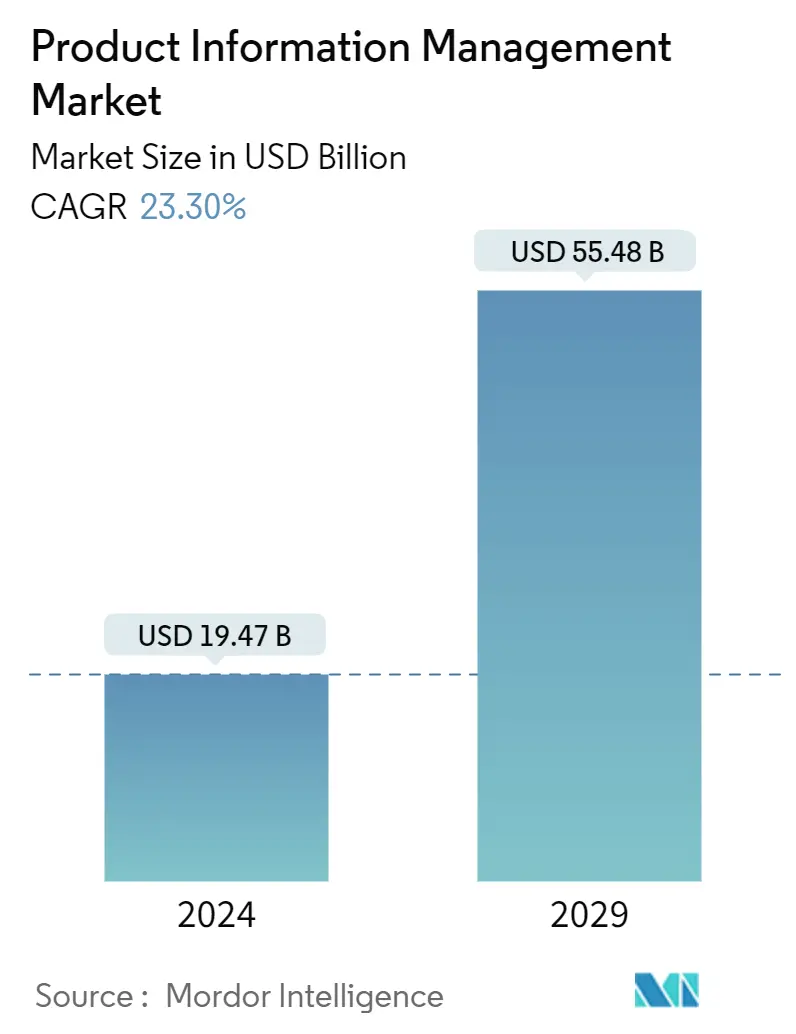Market Size of Product Information Management Industry

| Study Period | 2019 - 2029 |
| Market Size (2024) | USD 19.47 Billion |
| Market Size (2029) | USD 55.48 Billion |
| CAGR (2024 - 2029) | 23.30 % |
| Fastest Growing Market | Asia Pacific |
| Largest Market | North America |
Major Players
*Disclaimer: Major Players sorted in no particular order |
Need a report that reflects how COVID-19 has impacted this market and its growth?
Product Information Management Market Analysis
The Product Information Management Market size is estimated at USD 19.47 billion in 2024, and is expected to reach USD 55.48 billion by 2029, growing at a CAGR of 23.30% during the forecast period (2024-2029).
Product information management (PIM) solutions are processes and tools that unify and manage a business' product information to secure a single, accurate view of product data. PIM offers a centralized platform to collect data on a business's products and services cost-effectively. PIM promotes the maintenance of consistent and quality product data and information for all customers.
- A PIM system helps various organizations integrate various product information collected from multiple information sources, like core product data (product name, title, and description), product attributes (SKU, cost, and pricing), product specifications (e.g., dimensions, warranty, and packaging info), product-related metrics, omnichannel product information (e.g., mobile copy), extended channel information (Google/Amazon/Shopify/etc.), and store-specific information (POS registers and product catalogs).
- With the massive growth in data generation, data and information have become the backbone of organizations and businesses. Recently, more professionals have begun to pay attention to product information management (PIM) systems due to the growing demand for a better customer experience.
- The PIM software gained strong traction due to its growing application in the retail and e-commerce industries. It is helping offline retail outlets grow in digital spaces and assisting new concepts, like Amazon Go, leveraging customer data to build their product. With the expansion of retail and e-commerce businesses and the growing amount of product data to be managed, the adoption of PIM systems is on the rise.
- The demand for software-as-a-service (SaaS) versions of business applications has recently increased dramatically. Cloud-based PIM is becoming more popular among organizations that prefer the ease of deployment and collaboration, affordability, and the ability to scale.
- Amid COVID-19, vertically integrated brands and manufacturers that previously exercised tight control over the retail market with their brick-and-mortar stores witnessed a sudden loss of insight into the retail experience as they depended on e-commerce partners for sales. They do not have the same levels of visibility and control as they are used to when compared to a brick-and-mortar store. To avoid retailing on the e-commerce giant Amazon, brands have been focusing on e-commerce platforms, such as Shopify, which allow manufacturers to sell direct-to-consumer while maintaining their brand and customer data.
